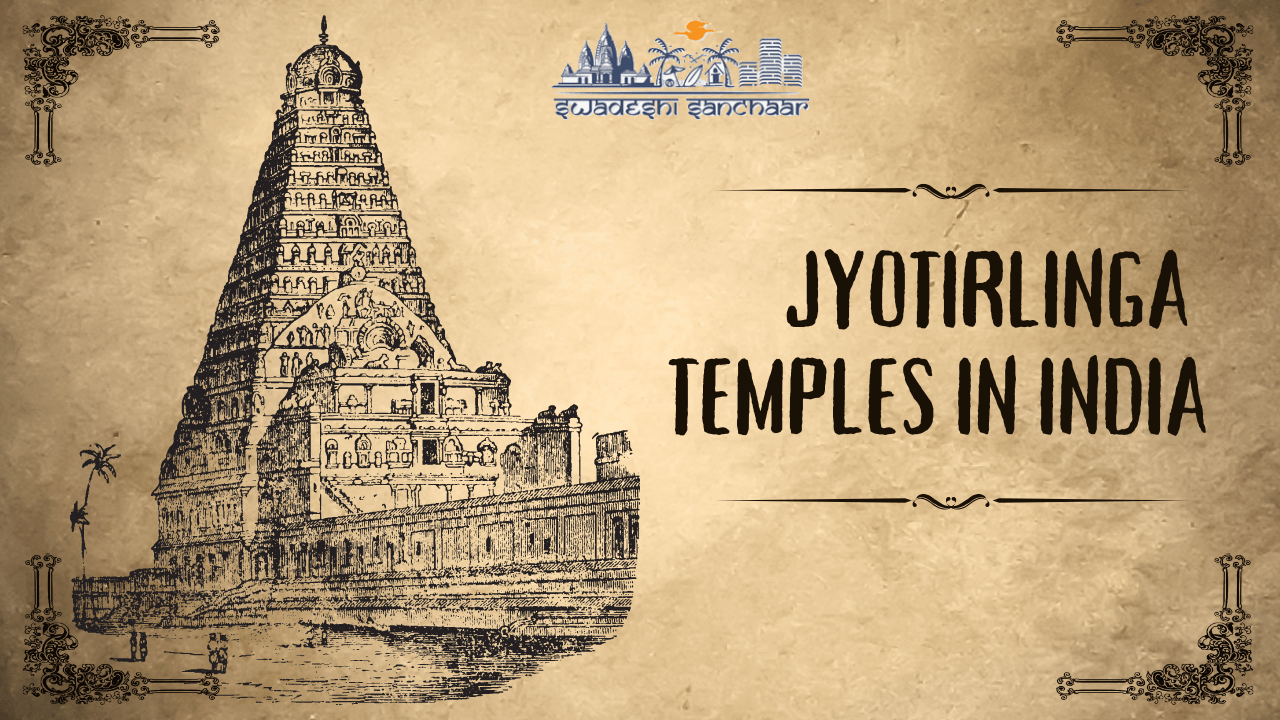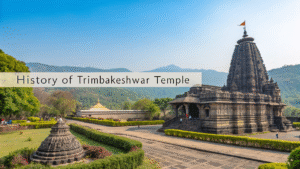The Jyotirlinga Temples in India are among the most revered shrines dedicated to Lord Shiva. These temples hold deep spirituality and attract millions of devotees seeking blessings. According to Hindu mythology, there are twelve Jyotirlinga Temples in India, each representing a different manifestation of Lord Shiva. Spread across the country, these sacred sites have unique legends associated with them.
The Legend of Jyotirlinga
The term “Jyotirlinga” means “pillar of light.” As per the Shiva Purana, Lord Brahma and Lord Vishnu once debated their supremacy. To settle this, Lord Shiva appeared as an infinite column of light, challenging them to find its beginning and end. While Lord Vishnu conceded defeat, Lord Brahma falsely claimed victory. Enraged by this, Lord Shiva cursed Brahma that he would never be worshipped. From then on, the Jyotirlinga Temples in India became divine centers of worship.
List of 12 Jyotirlinga Temples in India
1. Somnath Jyotirlinga (Gujarat)
Somnath, the first of the Jyotirlinga Temples in India, is located in Prabhas Patan, Gujarat. The temple’s name means “Lord of the Moon,” and according to legend, Chandra (Moon God) worshiped Lord Shiva here to regain his lost brilliance. Interestingly, the temple has been destroyed and rebuilt several times, with the current structure built in the Chalukya architectural style. Since Somnath is believed to be self-manifested, it is considered extremely sacred.
- Historically, it was one of the richest temples in ancient times.
- However, Mahmud of Ghazni raided it multiple times for its treasures.
- Moreover, the temple is located where the three holy rivers—Kapila, Hiran, and Saraswati—meet.
2. Mallikarjuna Jyotirlinga (Andhra Pradesh)
Located on the Shri Shaila Mountain in Andhra Pradesh, this temple is often called the “Kailash of the South.” The name Mallikarjuna is a combination of two words—Mallika (Goddess Parvati) and Arjuna (Lord Shiva). Interestingly, this temple is also a Shakti Peetha, making it an important pilgrimage site for both Shiva and Shakti devotees.
- It is believed that Lord Shiva and Goddess Parvati visit this temple every Amavasya (new moon) and Purnima (full moon).
- Furthermore, devotees believe that a visit to this temple ensures moksha (liberation).

3. Mahakaleshwar Jyotirlinga (Madhya Pradesh)
Situated in Ujjain, this is the only Jyotirlinga in India where Lord Shiva’s idol faces south. One of the most famous aspects of this temple is its Bhasma Aarti, where sacred ash from a fresh cremation is offered to the deity. According to legend, King Chandrasena, a devotee of Shiva, was protected by the Lord himself from a demon named Dushana.
- Notably, it is considered the most powerful Jyotirlinga.
- Additionally, the temple is built in five levels, including an underground chamber.
- Moreover, the sacred river Shipra flows nearby, adding to the temple’s spiritual aura.
4. Omkareshwar Jyotirlinga (Madhya Pradesh)
Omkareshwar is situated on an island shaped like the Hindu symbol “Om” in the Narmada River. Interestingly, there are two lingas in the region—Omkareshwar and Mamleshwar—both worshipped as Jyotirlingas. According to legend, King Mandhata and his sons performed penance here, leading to Lord Shiva’s manifestation as a divine light.
- As a result, it is one of the few Jyotirlingas associated with the sacred Om symbol.
- Furthermore, the temple hosts grand celebrations during Maha Shivaratri.
5. Kedarnath Jyotirlinga (Uttarakhand)
Located at an altitude of 3,583 meters in the Himalayas, Kedarnath is the most remote Jyotirlinga Temple in India. Furthermore, it is one of the Chota Char Dham pilgrimage sites and is open only for six months due to extreme weather. According to legend, the Pandavas built this temple after seeking forgiveness from Lord Shiva for their sins in the Kurukshetra war.
- It is believed that Lord Shiva took the form of a bull and merged into the earth here.
- Since it is in a mountainous region, devotees must trek 16 km from Gaurikund to reach the temple.
- Moreover, the temple is over 1,000 years old.
6. Bhimashankar Jyotirlinga (Maharashtra)
Located in the Sahyadri hills, Bhimashankar is between dense forests and wildlife. It is a belief that Lord Shiva defeated the demon Tripurasura here. The temple follows the Nagara architectural style and is a popular trekking destination.

- The Bhima River originates near this temple.
- The temple is a mix of spiritual significance and natural beauty.
7. Kashi Vishwanath Jyotirlinga (Uttar Pradesh)
Situated in Varanasi, this temple is the holiest among the Jyotirlinga Temples in India. It is a belief that visiting Kashi Vishwanath and dying in Varanasi grants moksha. The temple has been destroyed and rebuilt multiple times, with the current structure commissioned by Maharani Ahilyabai Holkar in the 18th century.
- The temple is a major center of learning and spirituality.
- It has close association with Adi Shankaracharya, Guru Nanak, and Swami Vivekananda.
- The famous Ganga Aarti takes place nearby at Dashashwamedh Ghat.
Also Read: Top 7 Most Famous Temples in Kashi
8. Trimbakeshwar Jyotirlinga (Maharashtra)
Located near Nashik, this temple is unique as it has three lingas representing Brahma, Vishnu, and Shiva. The temple is also the origin of the holy Godavari River. The linga is continuously covered with a silver crown, which is removed only during special rituals.
- Devotees believe that the temple’s water cures diseases.
- It is a major site for performing Narayan Nagbali Pooja, a ritual for ancestral peace.
9. Vaidyanath Jyotirlinga (Jharkhand)
Also known as Baidyanath Dham, it is a belief that this temple is the place where Ravana worshipped Lord Shiva by offering his ten heads. So pleased by his devotion, Lord Shiva granted him a boon, making him extremely powerful.
- Devotees believe that visiting this temple grants health and prosperity.
- The temple is associated with the legendary Kanwar Yatra, where devotees carry holy water from the Ganges.
10. Nageshwar Jyotirlinga (Gujarat)
Located near Dwarka, Nageshwar is believed to be the first Jyotirlinga to exist on Earth. According to legends, a demon named Daruka imprisoned Shiva’s devotee Supriya, and Lord Shiva manifested here to rescue her.
- The temple is known for its giant 25-meter-tall Shiva statue.
- The linga is unique as it faces south.
11. Ramanathaswamy Jyotirlinga (Tamil Nadu)
Located in Rameswaram, this temple has a link with Lord Rama’s journey in the Ramayana. It is a belief that Rama installed the Linga here before crossing the sea to Lanka. Moreover, the temple has the longest corridor among all Hindu temples.
- It is one of the Char Dham pilgrimage sites.
- The temple has 22 sacred wells, each with unique water properties.
12. Grishneshwar Jyotirlinga (Maharashtra)

Grishneshwar, the smallest Jyotirlinga, is near the Ellora Caves. The temple was rebuilt by Ahilyabai Holkar and follows the Hemadpanthi architecture style. Moreover, it is a belief that a woman named Kusuma, who devotedly worshipped Shiva, saw him manifest as this Jyotirlinga.
- It is the last of the 12 Jyotirlingas.
- The temple is famous for its intricately carved structures and sculptures.
Spiritual Importance of Jyotirlinga Temples in India
Visiting the Jyotirlinga Temples in India is a powerful way to attain spiritual enlightenment. Each temple has its own legend, emphasizing Lord Shiva’s divine presence and blessings. Further, devotees believe that praying at these temples removes obstacles, grants success, and purifies the soul.
Best Time to Visit Jyotirlinga Temples
It is possible to visit the Jyotirlinga Temples in India throughout the year, but the best time is during Shivaratri, Shravan Maas (July-August), and Kartik Maas (October-November). Moreover, during these periods, the temples are beautifully decorated, and special rituals take place.
Final Words on Jyotirlinga Temples in India
The Jyotirlinga Temples in India are not just religious sites but also symbols of India’s rich cultural heritage. Moreover, each temple has a unique significance, attracting devotees from all over the world. Visiting these sacred shrines strengthens faith and brings inner peace. Hence, if you seek divine blessings or wish to explore India’s spiritual legacy, the Jyotirlinga Temples in India offer an unparalleled experience.




